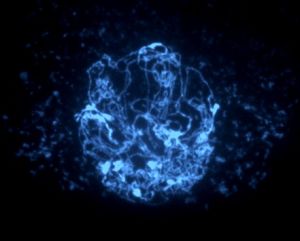Karlsruhe, Germany
April 30, 2012
Scientists of KIT and the University of Birmingham have identified relevant new functions of a gene that plays a crucial role in Fanconi anemia, a life-threatening disease. The FANCM gene is known to be important for the stability of the genome. Now, the researchers found that FANCM also plays a key role in the recombination of genetic information during inheritance. For their studies, the scientists used thale cress as a model plant. Their results are newly published by the journal The Plant Cell.

Leptotene stage during the meiosis of germ cells in thale cress: Halving of the number of the chromosomes is accompanied by a recombination of hereditary information. (Photo: Botanical Institute II, KIT)
Stability of the genome is ensured by a series of mechanisms. If these are lacking, the risk of cancer and other severe diseases is increased. Fanconi anemia is a recessive hereditary disease associated with dysplasia, degeneration of bone marrow, and an increased risk of leukemia and tumors. FANCM is one of the genes responsible for Fanconi anemia. So far, the deactivation of FANCM has been known to lead to genome instability in somatic cells, i.e. body cells that are not involved in reproduction. “We have now proven that FANCM does not only ensure genome stability in somatic cells, but also controls inheritance,” explains Dr. Alexander Knoll from the Botanical Institute II of KIT, first author of the publication in The Plant Cell.
According to the findings, FANCM plays a key role in the combination of paternal and maternal traits in the germ cells. The gene can be detected in nearly all organisms, from bacteria to yeast to plants to man. For their studies, the researchers from Karlsruhe and Birmingham used thale cress (Arabidopsis thaliana) as a model organism. The genome of this plant belonging to the family of cruciferous plants is relatively small and completely sequenced. The researchers found that the FANCM-homologous gene At-FANCM ensures ordered distribution and recombination of the genetic material during the meiosis of the germ cells in thale cress. “These findings cannot only be applied in biomedicine, but also in plant breeding in order to specifically improve the properties of usable crops,” explains the Head of the Botanical Institute II of KIT, Professor Holger Puchta.
Alexander Knoll, James D. Higgins, Katharina Seeliger, Sarah J. Reha, Natalie J. Dangel, Markus Bauknecht, Susan Schröpfer, F. Christopher H. Franklin, Holger Puchta (April 30, 2012). The fanconi anemia ortholog FANCM ensures ordered homologous recombination in both somatic and meiotic cells in Arabidopsis thaliana. Plant Cell, DOI: 10.1105/tpc.112.096644
Available online from Tuesday, May 1st: http://www.plantcell.org/content/early/recent
Schlüsselrolle des Gens FANCM bei der Vererbung nachgewiesen
Forscher des KIT und der Universität Birmingham haben relevante Funktionen eines Gens aufgeklärt, das bei der Entstehung der Fanconi-Anämie, einer lebensbedrohlichen Erkrankung, eine wesentliche Rolle spielt: Bekannt war, dass das Gen FANCM wichtig für die Stabilität des Erbguts ist. Nun haben die Forscher gezeigt, dass FANCM auch eine Schlüsselrolle für das Mischen der genetischen Informationen bei der Vererbung spielt. Für ihre Untersuchungen nutzten die Wissenschaftler die Ackerschmalwand als Modellpflanze. Ihre Ergebnisse stellen sie in der Zeitschrift The Plant Cell vor.

Leptotän-Stadium während der Reifeteilung der Keimzellen (Meiose) in der Ackerschmalwand: Mit der Halbierung der Zahl der Chromosomen erfolgt eine neue Zusammenstellung der Erbinformationen. (Abbildung: Botanisches Institut II, KIT)
Die Stabilität des Erbguts wird durch eine Reihe von Mechanismen gewährleistet. Fallen diese aus, ist das Risiko für Krebs und andere schwere Erkrankungen erhöht. Bei der Fanconi-Anämie handelt es sich um eine rezessiv vererbte Erkrankung, die mit Fehlbildungen, Rückbildung des Knochenmarks sowie einem erhöhten Risiko für Leukämien und Tumore einhergeht. FANCM ist eines der für die Fanconi-Anämie verantwortlichen Gene. Bisher war bekannt, dass das Ausschalten von FANCM zu Genominstabilität in somatischen Zellen führt, das heißt in Körperzellen, die nicht an der Reproduktion beteiligt sind. „Wir haben nun nachgewiesen, dass FANCM die Genomstabilität nicht nur in somatischen Zellen erhält, sondern auch die Vererbung kontrolliert“, erklärt Dr. Alexander Knoll vom Botanischen Institut II des KIT, Erstautor der Publikation in The Plant Cell.
Demnach spielt FANCM eine Schlüsselrolle bei der Durchmischung von väterlichen und mütterlichen Anlagen in den Keimzellen. Das Gen ist in fast allen Lebewesen von Bakterien über Hefe und Pflanzen bis hin zum Menschen nachweisbar. Für ihre Untersuchungen nutzten die Forscher aus Karlsruhe und Birmingham die Ackerschmalwand (Arabidopsis thaliana) als Modellorganismus. Das Genom dieser Pflanze, die zur Familie der Kreuzblütler gehört, ist relativ klein und vollständig sequenziert. Wie die Forscher feststellten, sichert das zu FANCM homologe Gen AtFANCM in der Ackerschmalwand die geordnete Verteilung und Anordnung von genetischem Material bei der Meiose, das heißt der Reifeteilung der Keimzellen. „Diese Erkenntnisse kommen nicht nur der Biomedizin zugute, sondern lassen sich auch in der Pflanzenzüchtung nutzen, um die Eigenschaften von Nutzpflanzen gezielt zu verbessern“, erklärt der Leiter des Botanischen Instituts II des KIT, Professor Holger Puchta.
Alexander Knoll, James D. Higgins, Katharina Seeliger, Sarah J. Reha, Natalie J. Dangel, Markus Bauknecht, Susan Schröpfer, F. Christopher H. Franklin, Holger Puchta: The Fanconi Anemia Ortholog AtFANCM Ensures Ordered Homologous Recombination in Both Somatic and Meiotic Cells in Arabidopsis thaliana. Plant Cell, DOI: 10.1105/tpc.112.096644
Online ab Dienstag, 1. Mai: http://www.plantcell.org/content/early/recent
Das Karlsruher Institut für Technologie (KIT) ist eine Körperschaft des öffentlichen Rechts nach den Gesetzen des Landes Baden-Württemberg. Es nimmt sowohl die Mission einer Universität als auch die Mission eines nationalen Forschungszentrums in der Helmholtz-Gemeinschaft wahr. Das KIT verfolgt seine Aufgaben im Wissensdreieck Forschung – Lehre – Innovation.